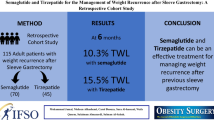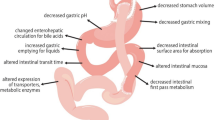Abstract
Background
Obesity is considered to be associated with high levels of oxidative stress and inflammation. Anticipated weight loss secondary to bariatric surgery may offer an opportunity to evaluate this association. We studied a few markers of oxidative stress and inflammation in 20 obese patients submitted to Roux-en-Y gastric bypass (RYGBP).
Methods
Variations in plasma levels of indicators of oxidative stress (malondialdehyde (MDA), superoxide dismutase (SOD), catalase, glutathione (GSH), glutathione disulfide (GSSG), and total radical antioxidant parameter (TRAP)) and inflammation (α1-acid glycoprotein (AGP) and C-reactive protein (CRP)), as well as variations in plasma levels of leptin, glucose, glycated hemoglobin (HbA1c), and insulin were investigated in the preoperative period and 12 months postsurgery in 20 class III obese individuals submitted to bariatric surgery (obese group) and 20 non-obese individuals (control group).
Results
Twelve months postsurgery, there was a significant reduction (p < 0.01) in median values of BMI (46.75/30.17 kg/m2) and in plasma levels of MDA (16.70/9.11 nmol/g prot), SOD (10.70/9.24 U/mgHb), GSSG (210.80/148.20 mM/g of Hb), AGP (125.70/75.80 mg/dL), CRP (1.31/0.38 mg/dL), and leptin (15.04/3.58 ng/mL). A significant drop (p < 0.05) in plasma levels of HbA1c (5.81/4.98%) was also observed. On the other hand, a significant increase in plasma levels of GSH (2.002/2.823 mM/g of Hb) and TRAP (585.40/815.48 μM Trolox®), p < 0.01, and in catalase plasma levels (12.06/13.22 Δt/mgHb/min), p < 0.05, was seen. No statistically significant variations in glucose (96.3/84.8 mg/dL) or insulin plasma levels (9.91/7.88 U/mL) occurred. Calculated homeostasis model assessment index did not statistically change 12 months postsurgery (2.36/1.66).
Conclusions
In the preoperative period, the obese group individuals showed higher oxidation and inflammation levels and lower indices of antioxidant defense than those of the control group. One year after RYGBP, an improvement in antioxidant protection, associated with a reduction in inflammatory and oxidative markers, was observed, indicating that these individuals presented a lower degree of oxidative stress.
Similar content being viewed by others
References
NIH. Weight control, obesity and nutritional disorders. National Institute of Health. NIH Publication no. 08-4006. 2004. http://win.niddk.nih.gov/publications/PDFs/gasurg12.04bw.pdf.
Pi-Sunyer FX. The obesity epidemic: pathophysiology and consequences of obesity. Obes Res. 2002;10(suppl.2):97S–104S.
Organização Pan-americana de Saúde. Doenças crônico degenerativas e obesidade: estratégia mundial sobre alimentação saudável, atividade física e saúde. Brasil. 2003; 60 p. http://www.opas.org.br/sistema/arquivos/d_cronic.pdf.
Instituto Brasileiro de Geografia e Estatística (IBGE). Pesquisa de Orçamento Familiar. 2004. http://www.ibge.gov.br/home/presidencia/noticias/noticiaimpressao.php?id noticia=278.
Kershaw EE, Flier JS. Adipose tissue as an endocrine organ. J Clin Endocrinol Metab. 2004;89(6):2548–56.
Coppack SW. Pro-inflammatory cytokines and adipose tissue. Proc Nutr Soc. 2001;60(3):349–56.
Wisse BE. The inflammatory syndrome: the role of adipose tissue cytokines in metabolic disorders linked to obesity. J Am Soc Nephrol. 2004;15:2792–800.
BRASIL. Ministério da Saúde. Portaria no. 196, de 29/2/00. Diário Oficial da República Federativa do Brasil, Brasília, seção 43-E de 1/3/00. 2000. http://sna.saude.gov.br/legisla/legisla/alta_gastro/GM_P196_00alta_gastro.doc.
Matthews DR, et al. Homeostasis model assessment: insulin resistance and β cell function from fasting plasma glucose and insulin concentrations in man. Diabetologia. 1985; 28(7): 412–19.
Jentzsch MA, Bachmann H, Furst P. 1996 Improved analysis of malondialdehide in human body fluids. Free Radic Biol Med. 1996;20:251–6.
Repetto M, et al. Oxidative stress in blood of HIV infected patients. Clin Chim Acta. 1996;29(255):107–17.
Tietze F. Enzymic method for quantitative determination of nanogram amounts of total and oxidized glutathione: applications to mammalian blood and other tissues. Anal Biochem. 1969;27(3):502–22.
Marklund S, Marklund G. Involvement of the superoxide anion radical in the autoxidation of pyrogallol and a convenient assay for superoxide dismutase. Eur J Biochem. 1974;47(3):469–74.
Aebi H. Catalase in vitro. Methods Enzymol. 1984;105:121–6.
Cummings DE, Overduin J, Schubert KEF. Gastric bypass for obesity: mechanisms of weight loss and diabetes resolution. J Clin Endocrinol Metab. 2004;89(6):2608–15.
Donath MY, Halban PA. Decreased beta-cell mass in diabetes: significance, mechanisms and therapeutic implications. Diabetologia. 2004;47(3):581–9.
Scopinaro N, et al. Long-term control of type 2 diabetes mellitus and the other major components of the metabolic syndrome after biliopancreatic diversion in patients with BMI <35 kg/m2. Obes Surg. 2007;17(2):185–92.
Geloneze B, Tambascia M. Avaliação Laboratorial e Diagnóstico da Resistência insulínica. Arq Bras Endocrinol Metab. 2006;50(2):208–15.
Oliveira EP, Souza MLA, Lima MDA. Índice HOMA (homeostasis model assessment) na Prática Clínica: Uma Revisão. J Bras Patol Med Lab. 2005;41(4):237–43.
Polizogopoulou EV, et al. Restoration of euglycemia and normal acute insulin response to glucose in obese subjects with type 2 diabetes following bariatric surgery. Diabetes. 2003;52:1098–103.
Rubino F, Gagner M. Potential of surgery for curing type 2 diabetes mellitus. Ann Surg. 2002;236(5):554–9.
American Diabetes Association. Diagnosis and classification of diabetes mellitus. Diabetes Care. 2007;30(suppl 1):S42–7.
Mohamed-Ali V, et al. β-Adrenergic regulation of IL-6 release from adipose tissue. In vivo and in vitro. J Clin Endocrinol Metab. 2001;86(12):5864–69.
Prasad K. C-Reactive protein increases oxygen radical generation by neutrophils. J Cardiovasc Pharmacol Therapeut. 2004;9(3):209–9.
Kopp HP, et al. Impact of weight loss on inflammatory proteins and their association with the insulin resistance syndrome in morbidly obese patients. Arterioscler Thromb Vasc Biol. 2003;23:1042–47.
Selvin E, et al. The effect of weight loss on C-reactive protein. Arch Intern Med. 2007;167:31–9.
Fournier T, Medjoubi NN, Porquet D. Alpha-1-acid glycoprotein. Biochim Biophys Acta Amsterdan. 2000;1482(1/2):157–71.
Auwerx J, Staels B. Leptin. Lancet. 1998;351:737–41.
Matarese G, Moschos S, Mantzoros C. Leptin in immunology. J Immunol. 2005;173:3137–42.
Singh P, et al. Leptin induces C-reactive protein expression in vascular endothelial cells. Arterioscler Thromb Vasc Biol. 2007;27:e302–7.
Boulomié A. Leptin induces oxidative stress in human endothelial cells. FASEB J. 1999;13:1231–38.
Furukawa S, et al. Increased oxidative stress in obesity and its impact on metabolic syndrome. J Clin Invest. 2004;114:1752–61.
Ribeiro SMR, et al. A formação e os efeitos das espécies reativas de oxigênio no meio biológico. Biosc J. 2005;21(3):133–49.
Del Rio D, Stewart AJ, Pelllegrini N. A review of recent studies on malondialdehyde as toxic molecule and biological marker of oxidative stress. Nutr Metab Cardiovasc Dis. 2005;15:316–28.
Dandona P, et al. The suppressive effect of dietary restriction and weight loss in the obese on the generation of reactive oxygen species by leukocytes, lipid peroxidation, and protein carbonylation. J Clin Endocrinol Metab. 2001;86(1):355–62.
Uzun H, et al. Changes in leptin, plasminogen activator factor and oxidative stress in morbidly obese patients following open and laparoscopic Swedish adjustable gastric banding. Obes Surg. 2004;14:659–65.
Dougall WC, Nick HS. Manganese superoxide dismutase: a hepatic acute phase protein regulated by interleukin-6 and glucocorticoids. Endocrinology. 1991;129:2376–84.
Sigfrid LA, et al. Cytokines and nitric oxide inhibit the enzyme activity of catalase but not its protein or mRNA expression in insulin-producing cells. J Mol Endoc. 2003;31:509–18.
Ashfaq S, et al. The relationship between plasma levels of oxidized and reduced thiols and early atherosclerosis in healthy adults. J Am Coll Cardiol. 2006;47:1005–11.
Ghiselli A, et al. Total antioxidant capacity as a tool to assess redox status: critical view and experimental data. Free Radic Biol Med. 2000;29(11):1106–14.
Vanucchi H, et al. Papel dos nutrientes na peroxidação lipídica e no sistema de defesa anti-oxidante. Medicina. 1998;31:31–44.
Carlini MP. Avaliação Nutricional e de Qualidade de Vida de Pacientes Submetidos à Cirurgia Bariátrica. 2001. Dissertação de Mestrado (Mestrado em Engenharia De Produção)—Universidade Federal De Santa Catarina. Florianópolis.
Author information
Authors and Affiliations
Corresponding author
Rights and permissions
About this article
Cite this article
João Cabrera, E., Valezi, A.C., Delfino, V.D.A. et al. Reduction in Plasma Levels of Inflammatory and Oxidative Stress Indicators After Roux-En-Y Gastric Bypass. OBES SURG 20, 42–49 (2010). https://doi.org/10.1007/s11695-009-9988-2
Received:
Accepted:
Published:
Issue Date:
DOI: https://doi.org/10.1007/s11695-009-9988-2




